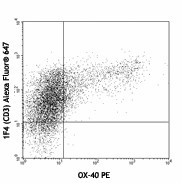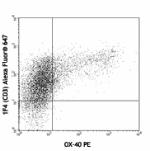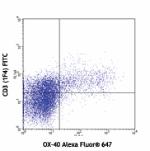- Clone
- OX-40 (See other available formats)
- Regulatory Status
- RUO
- Other Names
- OX-40 receptor , TNFRSF4, ACT35, OX40
- Isotype
- Mouse IgG2b, κ
- Ave. Rating
- Submit a Review
- Product Citations
- publications

-

Con A-stimulated LOU rat splenocytes (Day 3) stained with anti-rat CD3 (1F4) Alexa Fluor® 647 and OX-40 PE
| Cat # | Size | Price | Quantity Check Availability | Save | ||
|---|---|---|---|---|---|---|
| 204508 | 100 µg | $238 | ||||
CD134 (OX-40 receptor)is a 50 kd type I membrane protein, expressed on activated T cells.It binds to the OX-40 ligand (CD252) to provide a co-stimulatory signal that is independent of CD28.It is reported to block binding of CD134 and CD252.
Product DetailsProduct Details
- Verified Reactivity
- Rat
- Antibody Type
- Monoclonal
- Host Species
- Mouse
- Formulation
- Phosphate-buffered solution, pH 7.2, containing 0.09% sodium azide.
- Preparation
- The antibody was purified by affinity chromatography, and conjugated with PE under optimal conditions.
- Concentration
- 0.2 mg/ml
- Storage & Handling
- The antibody solution should be stored undiluted between 2°C and 8°C, and protected from prolonged exposure to light. Do not freeze.
- Application
-
FC - Quality tested
- Recommended Usage
-
Each lot of this antibody is quality control tested by immunofluorescent staining with flow cytometric analysis. For flow cytometric staining, the suggested use of this reagent is ≤0.25 µg per million cells in 100 µl volume. It is recommended that the reagent be titrated for optimal performance for each application.
- Excitation Laser
-
Blue Laser (488 nm)
Green Laser (532 nm)/Yellow-Green Laser (561 nm)
-
Application References
(PubMed link indicates BioLegend citation) -
- Al-Shamkhani A, et al. 1996. Eur J. Immunol. 26:1695
- RRID
-
AB_2256385 (BioLegend Cat. No. 204508)
Antigen Details
- Structure
- 50 kd type I integral membrane protein, member of NGFR/TNFR superfamily.
- Distribution
- Expressed mainly on activated CD4+ and CD8+ T cells.
- Function
- Binds to the OX-40 ligand (CD252) to provide a co-stimulatory signal for T cells.
- Ligand/Receptor
- CD252 (OX-40 ligand)
- Cell Type
- T cells
- Biology Area
- Immunology
- Molecular Family
- CD Molecules, Immune Checkpoint Receptors
- Antigen References
-
1. Al-Shamkhani A et al. 1996. Eur. J. Immunol. 26:1695
2. Paterson DJ et al. 1987. Mol Immunol 24:1281 - Gene ID
- 25572 View all products for this Gene ID
- UniProt
- View information about CD134 on UniProt.org
Related FAQs
- What type of PE do you use in your conjugates?
- We use R-PE in our conjugates.
Other Formats
View All CD134 Reagents Request Custom Conjugation| Description | Clone | Applications |
|---|---|---|
| PE anti-rat CD134 (OX-40) | OX-40 | FC |
| Alexa Fluor® 647 anti-rat CD134 (OX-40) | OX-40 | FC |
Compare Data Across All Formats
This data display is provided for general comparisons between formats.
Your actual data may vary due to variations in samples, target cells, instruments and their settings, staining conditions, and other factors.
If you need assistance with selecting the best format contact our expert technical support team.
-
PE anti-rat CD134 (OX-40)

Con A-stimulated LOU rat splenocytes (Day 3) stained with an... -
Alexa Fluor® 647 anti-rat CD134 (OX-40)

ConA-stimulated LOU rat splenocytes stained with OX-40 Alexa...

 Login/Register
Login/Register 













Follow Us